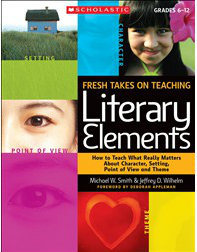Teaching Literary Elements
Fresh Takes on Teaching Literary Elements:
How to Teach What Really Matters About Character, Setting, Point of View and Theme
By Michael W. Smith and Jeffrey D. Wilhelm
(Scholastic/NCTE, 2010 – Learn more)
 Reviewed by Mark A. Domeier
Reviewed by Mark A. Domeier
Michael Smith and Jeffrey Wilhelm are accomplished collaborators, as evidenced by a number of previous books they’ve written in the realm of English education. Both have extensive experience in the classroom and are now college instructors. The previous experience in the classroom gives them credence when writing Fresh Takes on Teaching Literary Elements, but as is often the case once one moves to the college scene, it quickly becomes obvious that being removed from life in grades 6-12 distances an educator from the realities of teaching today.
First, the good. I jumped at the opportunity to read this book based on the ideas of character, setting, point of view, and theme. These are all ideas that are incorporated in my junior high classroom, and I’m always looking for new ideas for older concepts. My attention was grabbed right away with the authors’ theoretical ideas and sound basis for change in instruction.
 I’ve never been one for diving too deeply into educational theory. Those types of essays and books tend to get self-righteous in a hurry and throw together a lot of terms and phrases meant to sound highly educated. However, Smith and Wilhelm do a fine job of mixing theory and practical applications of it. There is just the right amount of theory before getting to how to use it in the classroom. It can be likened to starting a class session with a brief lecture to give some background before launching into a class project.
I’ve never been one for diving too deeply into educational theory. Those types of essays and books tend to get self-righteous in a hurry and throw together a lot of terms and phrases meant to sound highly educated. However, Smith and Wilhelm do a fine job of mixing theory and practical applications of it. There is just the right amount of theory before getting to how to use it in the classroom. It can be likened to starting a class session with a brief lecture to give some background before launching into a class project.
Some of the ideas seem to have some real merit. In fact, I found one that I plan to use within the month as I begin teaching The Outsiders. The idea of using a personality test like those in teenage magazines and on Facebook to integrate characterization fits that novel to a T. Other activities popped up throughout, immediately jumping to my mind as usable for various curriculum units. Any teacher who reads this book will most likely have the same response at various points: Wow! That’s something I can use!
Unit structures not a good fit for middle school
However, that’s where the usefulness ends. The authors admit numerous times that their overarching ideas for spending weeks on each of these four areas might be difficult to pull off. That’s the absolute truth in today’s standards/test-driven world. There simply is not enough time to give over an extensive unit purely to point of view, etc. If one were teaching a literature-only class, these would be wonderful; in fact, I will be recommending this to some of my high school peers who teach elective classes focused only on literature.
Many of us don’t have classes like that. For example, I need to teach literature, writing, and language arts all in one class, much like many of my peers. By the time the authors get around to suggesting a solution to this problem, the reader is already turned off by the overwhelming idea of such a revamped curriculum and what to cut out of the current plans.
The solution, according to the authors? Take a middle school concept and have each year focus on one or two of these areas. However, that simply doesn’t work. I’ve tried doing that, and if the concepts are not followed up on throughout one year and into the next, they are lost.
Another problem with this book is that, though it is listed as applying to grades 6-12, I found very little that might work in 6-8, unless you had a strictly upper-level group of students. Most of us fight lack of motivation every day, much less getting into three layers of setting. If three-quarters of my students know that setting involves time and location, I’m happy. I will not try to go into global consequences of setting. Plus, many of the story references are to works that would be taught at a high school level. There will be no comedy/tragedy discussions in middle school.
Again, an educator can read this and find some useful ideas, which makes it worth the quick read that it is. However, if the authors take off the rose-colored glasses and realize that we need quick routes to teaching the horde of material we are expected to get through, that might make a more useful read.
Mark A. Domeier is an English teacher in the New Richland-Hartland-Ellendale-Geneva school district in southern Minnesota. He has been teaching junior high English there for 18 years. Mark earned his bachelor’s degree from Winona State University and his Master’s degree from St. Mary’s University, both in Minnesota. He recently published Heroics 201, a sequel to his debut novel, Heroics 101, a YA novel about super heroes in a realistic world.

































